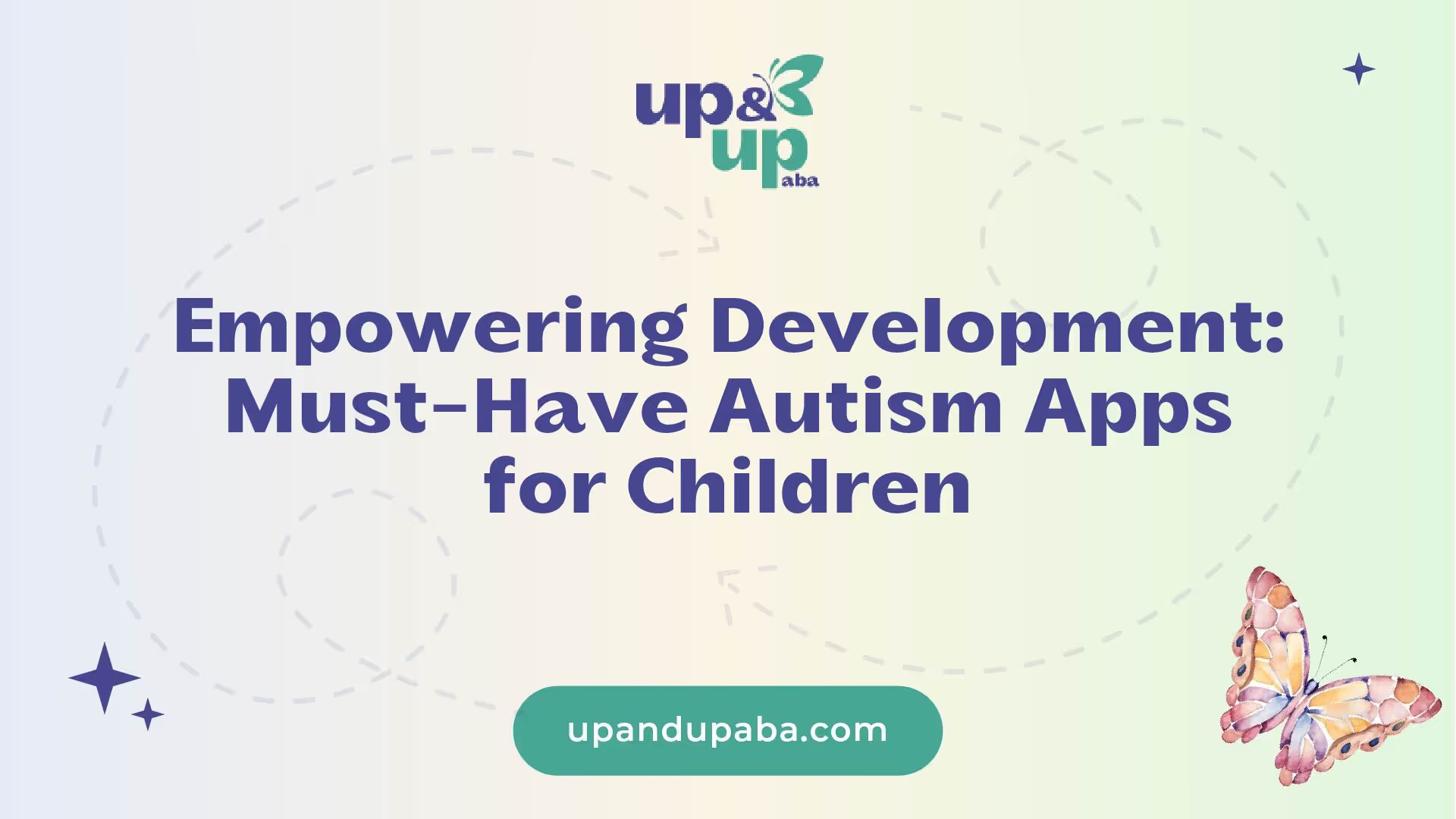Empowering Development: Must-Have Autism Apps for Children
Discover essential autism apps for children that enhance learning, promote independence, and support development.
.avif)
Understanding Autism Apps for Children

Importance of Technology in Autism Development
Technology plays a significant role in the development of children with autism. The evolution of mobile applications has created opportunities for enhanced communication, learning, and social interaction. With the increasing prevalence of smartphones and tablets, these digital tools are becoming integral to the support system for children on the autism spectrum.
Many parents and educators find that utilizing technology can bridge communication gaps. Apps designed specifically for autism can provide children with visual aids and structured learning environments that cater to their unique needs. The accessibility of these resources allows for engagement and interaction in a way that traditional learning methods may not achieve.
How Autism Apps Can Assist Children
Autism applications can assist children in various ways, catering to their developmental goals. These apps can promote essential skills, improve understanding, and foster independence. Below are some key functions of autism apps for children:
FunctionDescriptionCommunicationFacilitate expressive and receptive language skills.Learning SkillsOffer educational content in an engaging format.Social SkillsTeach social interactions and appropriate behaviors.Behavior ManagementAid in tracking and managing challenging behaviors.Visual SupportsProvide visual cues for understanding concepts.
These functionalities support children in navigating their daily lives, enhancing their learning experiences and aiding in the development of critical life skills. By focusing on specific areas, autism apps ultimately empower children with autism to thrive in various environments, from home to school.
Features to Look for in Autism Apps
When considering autism apps for children, it is essential to identify key features that can effectively support their development. Two significant areas to focus on are visual supports and communication aids, as well as skill development and reinforcement activities.
Visual Supports and Communication Aids
Visual supports play a vital role in helping children with autism understand and engage with their environment. Apps that provide visual aids can enhance communication and comprehension through the use of pictures, symbols, and videos. These elements can assist in reducing frustration and fostering meaningful interactions.
Key features to consider include:
FeatureDescriptionPicture Exchange SystemsAllows children to communicate through images concise messages.Visual TimersHelps children understand time management and transitions.Social StoriesUses scenarios to explain social situations and expected behaviors.Interactive ChartsOffers visual tracking of daily activities or emotions.
Skill Development and Reinforcement Activities
Skill development is critical for children with autism to gain independence and cope with everyday challenges. Apps that incorporate reinforcement activities can motivate children while building essential skills. It is vital to look for apps that provide engaging and enjoyable ways to learn.
Key features to consider include:
FeatureDescriptionInteractive GamesProvides playful platforms for learning various skills.Progress TrackingAllows parents and educators to monitor progress and adjust activities accordingly.Customized Learning PathsTailors activities based on individual skill levels and interests.Positive ReinforcementEncourages children with rewards or incentives for task completion.
By focusing on these features, parents and caregivers can select autism apps that will assist children in learning, communication, and overall development.
Types of Autism Apps
When looking for suitable autism apps for children, it is helpful to categorize them based on their primary function. The three main types are communication apps, educational apps, and behavior management apps. Each type has its unique features designed to address specific aspects of a child's development.
Communication Apps
Communication apps are designed to support expressive and receptive language skills. They provide various tools to help children communicate their needs, thoughts, and feelings effectively. These apps often include visual supports, symbol systems, and text-to-speech functionalities.
FeatureDescriptionPicture Exchange Communication System (PECs)Uses pictures to help children express their wants and needs.Text-to-SpeechConverts written text into spoken words, facilitating communication.Vocabulary BuilderOffers a range of words and phrases to enhance language skills.
Educational Apps
Educational apps focus on academic learning and skill development. They often include interactive games, quizzes, and activities that cater to various subjects, such as math, literacy, and science. These apps aim to create an engaging learning environment.
FeatureDescriptionInteractive Learning GamesEngaging games that teach concepts in a fun way.Progress TrackingAllows parents and teachers to monitor a child's learning journey.Customizable ContentAdapts to the child's learning pace and preferences.
Behavior Management Apps
Behavior management apps assist in promoting positive behaviors and reducing challenging ones. These apps often include tracking systems, reward systems, and strategies for handling specific behavioral issues.
FeatureDescriptionBehavior TrackingMonitors incidents of specific behaviors over time.Reward SystemsEncourages positive behavior through a system of rewards.Visual SchedulesProvides structured routines to help children understand daily expectations.
By understanding the various types of autism apps, caregivers can make informed decisions when selecting apps that will benefit children's growth and development in communication, learning, and behavior management.
Selecting the Right App for Your Child
Choosing the appropriate autism apps for children requires careful consideration of individual needs and professional input. This section highlights two crucial steps in the selection process: assessing the child's needs and consulting with professionals.
Assessing Your Child's Needs
When selecting an app, it is important to evaluate the unique requirements and preferences of the child. This assessment should consider various aspects of the child's development, including communication skills, learning style, and behavioral challenges.
Assessment CriteriaConsiderationsCommunication SkillsEvaluate if the child requires support with expressing needs or wants.Learning StyleIdentify if the child benefits from visual aids, auditory prompts, or hands-on activities.Behavioral ChallengesConsider if the child experiences difficulties in managing emotions or routines.Age AppropriatenessEnsure the app is suitable for the child's developmental stage.User-FriendlinessCheck if the interface is engaging and easy for the child to navigate.
Understanding these factors can help caregivers focus on apps that specifically address the child's developmental areas, maximizing the potential benefits.
Consulting with Professionals
Engaging with professionals such as speech therapists, occupational therapists, and educators can provide valuable insights when selecting an app. These experts can offer tailored advice based on their experiences and understanding of the child's needs.
Professional ConsultantRoleSpeech TherapistEvaluates communication skills and recommends apps to enhance verbal or non-verbal communication.Occupational TherapistAssesses motor skills and suggests apps that reinforce motor development and daily living skills.Special Education TeacherProvides insights on educational tools and considers the child's learning objectives.Behavioral AnalystOffers advice on behavior management apps and reinforcement techniques.
Collaboration with these professionals fosters an informed decision-making process, ensuring that the selected apps will effectively support the child's growth and development. By combining personal assessments with expert guidance, caregivers can confidently choose the most suitable autism apps for their child.
Incorporating Autism Apps Into Daily Routine
Integrating autism apps into a child's daily activities can enhance learning and development. It is vital to approach this integration thoughtfully to maximize the benefits.
Setting Appropriate Usage Limits
Establishing time limits for app usage is essential to ensure a balanced routine. Too much screen time can lead to distractions and unintended effects. Parents and caregivers are encouraged to set clear guidelines on when and how long children can engage with these apps.
Age GroupRecommended Daily Usage (minutes)2 - 5 years20 - 306 - 10 years30 - 6011 - 14 years60 - 90
Using timers or reminders can assist in adhering to these limits. Regular breaks should also be scheduled to encourage physical activity and social interaction.
Monitoring Progress and Adjustments
Tracking the child's progress with autism apps is a critical step in ensuring they meet their developmental goals. Parents and caregivers can keep a log of the app’s usage, noting which skills improve and which areas may require more attention.
Tracking AspectDescriptionSkill ImprovementMonitor specific skills or behaviors that the app targets.Engagement LevelNote how much interest the child shows while using the app.Time SpentRecord daily or weekly usage for adherence to limits.
Feedback from both the child and professionals can provide insights into how well the apps are supporting learning. Adjustments can then be made to usage schedules, app selections, or developmental goals based on this monitored progress. Regular reviews can help optimize the benefits of autism apps for children, ensuring they align with the child's evolving needs.
Empowering Children with Autism Apps
Enhancing Learning and Development
Autism apps for children play a significant role in facilitating learning and development. These applications provide interactive experiences that engage children and cater to diverse learning styles. By utilizing visuals, audio, and touch interaction, these apps create a dynamic learning environment that can stimulate cognitive growth.
The following table outlines key areas where autism apps contribute to learning:
Learning AreaBenefits of AppsCommunicationImprove expressive and receptive language skills.Social SkillsFoster interaction and understanding of social cues.Daily Living SkillsTeach practical skills for independence, such as routines.Academic SkillsReinforce subjects like math, reading, and science through engaging activities.
Promoting Independence and Confidence
Using autism apps empowers children to develop a sense of independence and self-confidence. These tools can help children learn to manage tasks on their own, promoting autonomy in daily activities. With guided instructions and visual supports, children can navigate challenges with less assistance.
The table below highlights how autism apps foster independence and confidence:
AspectImpact on ChildrenTask ManagementHelps children learn to follow steps and complete tasks independently.Problem-Solving SkillsEncourages children to think critically and find solutions.Self-MonitoringAllows children to track their activities and progressPositive ReinforcementMotivates children through rewards, enhancing their self-esteem.
By integrating autism apps into everyday activities, children can improve their learning experiences while gaining the confidence needed for personal growth.



